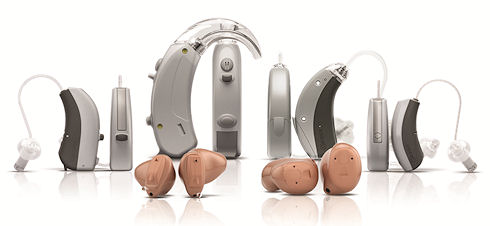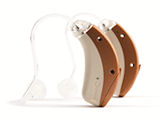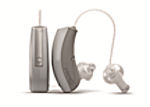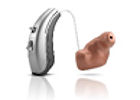Hearing Aids |
Hearing aids are available in more styles and sizes than ever before; thanks to miniaturization of electronics and a new focus in the hearing industry on style and design. Now, more and more people can wear tiny, nearly invisible models, or sleek styles that are much less conspicuous than the latest Bluetooth headsets. |

|
What Is a Hearing Aid
A hearing aid is an electronic, battery-operated device that amplifies and changes sound to allow for improved communication. Hearing aids receive sound through a microphone, which then converts the sound waves to electrical signals. The amplifier increases the loudness of the signals and then sends the sound to the ear through a speaker.
Digital Hearing Aids
The most common complaint of the hard-of-hearing population is that they don't have good communication ability in noisy environments or in group conversations. It's particularly in those situations that digital technology is able to provide better benefits to people. We offer a wide range of digital hearing aids, from entry level digital to premium digital technology that are custom fit to your hearing needs.
Benefits of Wearing Hearing Aids
With the use of a hearing aid you could experience fewer repetitions and interruptions during conversations with friends and family, dangerous situations in traffic could be avoided, and you could rediscover all those captivating sounds of nature: Waves crashing against the shore, birds twittering in the park, and leaves rustling in the wind. Many people hesitate to take the necessary action to overcome their disability, which could enable them to return to a full and active lifestyle. |
In-the-Ear Styles |
 |
Completely-in-the-Canal (CIC)
The smallest custom style, CIC instruments fit entirely within the ear canal. They fit mild to moderate hearing losses and they’re nearly invisible when worn. |
 |
In-the-Canal (ITC)
ITC instruments sit in the lower portion of the outer ear bowl, making them comfortable and easy to use. Because they’re slightly larger than CIC models, they have a longer battery life, and can host additional features such as directional microphones for better understanding in noisy environments. They fit mild and moderate hearing losses. |
 |
Half Shell (HS)
Half shell models fill half the bowl of the outer ear. Like ITC models, their size enables the addition of features such as directional microphones. Because of their size, they may be easier than smaller models to handle for some people. |
 |
Full Shell or In-the-Ear (ITE)
Full shell models sit flush within the outer ear bowl. Their size also allows additional features such as directional microphones. They use a larger battery size than the smaller styles, and can fit a larger receiver with enough power for even some severe hearing losses. Because of their flexibility, they’re widely recommended for mild to severe hearing loss. |
|
Behind-the-Ear Styles |
 |
Mini BTE with slim tube and tip
Mini BTEs are designed to hide behind the outer ear, and have ultra-thin tubing to discreetly route sound into the ear. The tubing connects to a soft tip that sits in the ear canal but doesn’t occlude it. The result is a natural, open feeling as airflow and sound enter the ear naturally around the tip, while amplified sound enters through the tip. This is known as “open fitting” and is recommended for mild to moderate high frequency losses. |
 |
Receiver in the Ear (RITE)
RITE models, also known as RIC (receiver-in-canal) models, are mini BTEs that have the speaker of the instrument incorporated in the ear tip, instead of in the main body of the instrument. This design also provides an open feeling in the ear. RITE instruments fit mild to severe hearing losses. |
 |
BTE with Ear Mold
BTEs with ear molds fit mild through profound hearing losses. They’re longer shape, following the contour behind the outer ear, generally can house more features, controls, and power than custom models. The ear mold color and style, as well as the wearer’s hairstyle, determine exactly how they’ll look on each person. |
|
| |